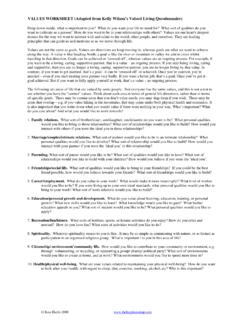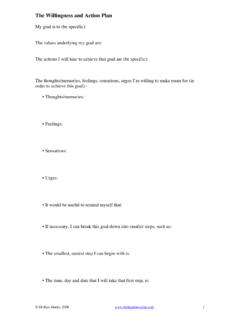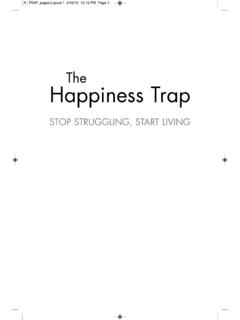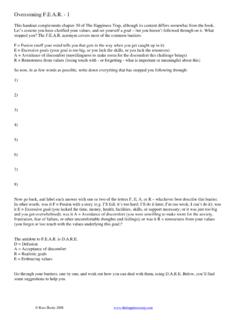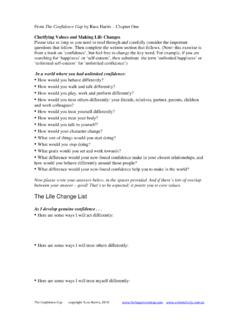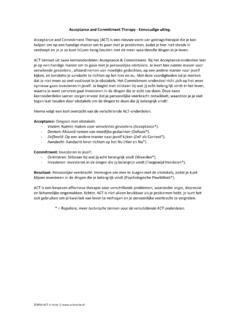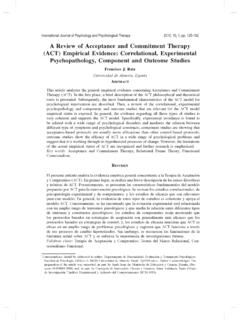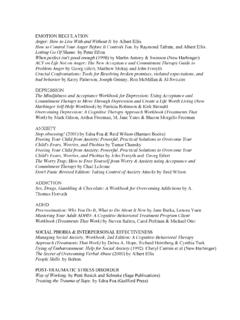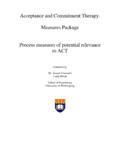Transcription of Worksheets To Use With The Happiness Trap
1 Worksheets To Use With The Happiness Trap The Worksheets in this compilation are designed to be used in conjunction with The Happiness Trap. If you are working with a coach or therapist, they will probably want you to fill them in and bring them into your sessions. As a general rule, read the chapter first, and then take a look at the worksheet ; it should then be self-explanatory. Many of these Worksheets you will want to use repeatedly for different issues in different areas of your life. I hope you find them helpful. All the best, Russ Harris Chapter 1: Control of Thoughts and Feelings Questionnaire Chapter 2: a) Costs of Avoidance worksheet Chapter 2: b) Avoidance and Suffering Diary Chapter 9: Defusion Practice worksheet Chapter 13: Expansion Practice worksheet Chapter 18: Informal Mindfulness Practice Chapter 20: Mindful Breathing Practice worksheet Chapter 25: a) The Life Values Questionnaire Chapter 25: b) Detailed Bull's Eye worksheet Chapter 25: c) Brief Bull's Eye worksheet Chapter 27: Goal Setting worksheet Chapter 30: Overcoming worksheet Chapter 31: The Willingness and Action Plan Appendix: What To Do In A Crisis How to Get the Most Out Of The Happiness Trap'.
2 Reading the Book There are two ways to read the book. You can either work through it slowly and steadily, doing the exercises as you go. Or you can read it from cover to cover very rapidly, and then go back and work through it at your leisure. You can also enhance the exercises in the book by using the free online resources at Stuck or Confused? If you ever get stuck or confused, I'd suggest you join the Yahoo list serve, entitled ACT for the Public': There's no cost involved. You can post emails to the group if ever you are confused, or concerned, or just bogged down and you will quickly receive supportive responses from other members of the public and/or from the many therapists (including myself) who are also on the list. Prioritize Your Health and Wellbeing If you are a typical reader, then you are already a very busy person. You are juggling multiple demands and rarely have any time left over for yourself.
3 Thus, if you want this book to make a real difference in your life, you will have to put your health and wellbeing above some of the other demands upon your time. Can you schedule in some time for reading? Can you schedule in some time for practicing the exercises? Even 30. minutes a day to read and/or practice can make a huge difference. Are you willing to give up 30 minutes of TV. or other time-eating activities? Practice Whoever said Practice makes perfect was lying. But practice does lead to improvement. Like any new skills, the exercises and strategies in this book do require practice they do not come naturally, or magically happen simply as a result of reading. And like any new skill, the more you practice it, the easier it becomes and the more naturalistic. Be Patient Be patient with yourself. As you work through the book, there are times when you will inevitably screw up, fail, and forget things.
4 This is because you are a human being, not a saint or a guru or a superhero. So please, allow yourself permission to be human. And give yourself as much time as you need to get a good handle on your new skills. Consider Using a CD or MP3 Recording The CDs and MP3 recordings available from have been specifically designed for use with this book. They will substantially enhance the benefits of the book for you. Mindfulness skills are much easier to develop initially when you have a voice guiding you. Repetition I intended The Happiness Trap to be the sort of book that you read not just once, but again and again. My hope is that after you've been through it once, you repeatedly revisit it. The small chapters make it an ideal book for dipping into. Working With a Coach or Therapist: While The Happiness Trap is primarily written as a self-help book for use on your own, it is also a valuable adjunct to therapy and coaching.
5 Indeed the book flows along, chapter by chapter, in much the same way as you might typically work with a coach or therapist. If your therapist or coach has done some training in ACT. they will be familiar with many of the exercises and metaphors in the book, but probably not all of them, so it is a good idea if they read the book too. You can use the book as an adjunct in two main ways: 1. You can read a chapter or two (or three) before each session, then discuss in session how the reading applies to you, and then practice the relevant exercises during the session. 2. You can read relevant chapters after a session, to build on what you have experienced or learned during the session. Whichever way you do it, the Worksheets from the free resources section can be very helpful; use them as you are reading the relevant chapter. To Find an ACT Therapist If you want to find an ACT therapist in Australia, click here If you want to find an ACT therapist in USA, UK and other countries, click here I hope you enjoy reading it and I trust you'll find it helpful Cheers, Russ Harris Control of Thoughts and Feelings Questionnaire This questionnaire has been adapted from similar ones developed by Steven Hayes, Frank Bond, and others.
6 For each pair of statements, please circle the one that most accurately fits how you feel. The answer you choose doesn't have to be absolutely 100 percent true for you all the time; just pick the answer which seems to be more representative of your general attitude. 1a. I must have good control of my feelings in order to be successful in life. 1b. It is unnecessary for me to control my feelings in order to be successful in life. 2a. Anxiety is bad. 2b. Anxiety is neither good nor bad. It is merely an uncomfortable feeling. 3a. Negative thoughts and feelings will harm you if you don't control or get rid of them. 3b. Negative thoughts and feelings won't harm you even if they feel unpleasant. 4a. I'm afraid of some of my strong feelings. 4b. I'm not afraid of any feelings, no matter how strong. 5a. In order for me to do something important, I have to get rid of all my doubts.
7 5b. I can do something important, even when doubts are present. 6a. When negative thoughts and feelings arise, it's important to reduce or get rid of them as quickly as possible. 6b. Trying to reduce or get rid of negative thoughts and feelings frequently causes problems. If I simply allow them to be, then they will change as a natural part of living. 7a. The best method of managing negative thoughts and feelings is to analyze them; then utilize that knowledge to get rid of them. 7b. The best method of managing negative thoughts and feelings is to acknowledge their presence and let them be, without having to analyze or judge them. 8a. I will become happy and healthy by improving my ability to avoid, reduce, or get rid of negative thoughts and feelings. 8b. I will become happy and healthy by allowing negative thoughts and feelings to come and go of their own accord and learning to live effectively when they are present.
8 9a. If I can't suppress or get rid of a negative emotional reaction, it's a sign of personal failure or weakness. 9b. The need to control or get rid of a negative emotional reaction is a problem in itself. 10a. Having negative thoughts and feelings is an indication that I'm psychologically unhealthy or I've got problems. 10b. Having negative thoughts and feelings means I'm a normal human being. 11a. People who are in control of their lives can generally control how they feel. 11b. People who are in control of their lives do not need to control their feelings. 12a. It is not okay to feel anxious and I try hard to avoid it. 12b. I don't like anxiety, but it's okay to feel it. 13a. Negative thoughts and feelings are a sign that there is something wrong with my life. 13b. Negative thoughts and feelings are an inevitable part of life for everyone. 14a.
9 I have to feel good before I can do something that's important and challenging. 14b. I can do something that's important and challenging even if I'm feeling anxious or depressed. 15a. I try to suppress thoughts and feelings that I don't like by just not thinking about them. 15b. I don't try to suppress thoughts and feelings that I don't like. I just let them come and go of their own accord. To score your test, count the number of times you selected option a or b.. You may like to repeat this test and see how your ideas have changed, after you have finished reading The Happiness Trap, or completed several sessions of ACT. Russ Harris 2008 The Costs of Avoidance worksheet Complete the following sentences: The thoughts I'd most like to get rid of are: The feelings I'd most like to get rid of are: The sensations I'd most like to get rid of are: The memories I'd most like to get rid of are: Next, take a few minutes to write a list of every single thing you've tried in order to avoid or get rid of these unpleasant thoughts or feelings.
10 Try to remember every strategy you have ever used (whether deliberately or by default). Below is a guide to help you: Distraction: list everything you have ever done to distract yourself from, or zone out', or take your mind off these painful thoughts, feelings, sensations or memories. Opting out: list all the activities, interests, events, people, or places that you have avoided or withdrawn from, and all the opportunities you have missed out on, because you did not feel good or wanted to avoid feeling bad: Russ Harris 2008 Thinking strategies: list all the different ways of thinking you have tried (deliberately or unintentionally) when painful thoughts and feelings started showing up. Tick any of the following that you have done, and write in any others: Worrying Dwelling on the past Fantasizing about the future Imagining escape scenarios (eg leaving your job or your partner).



